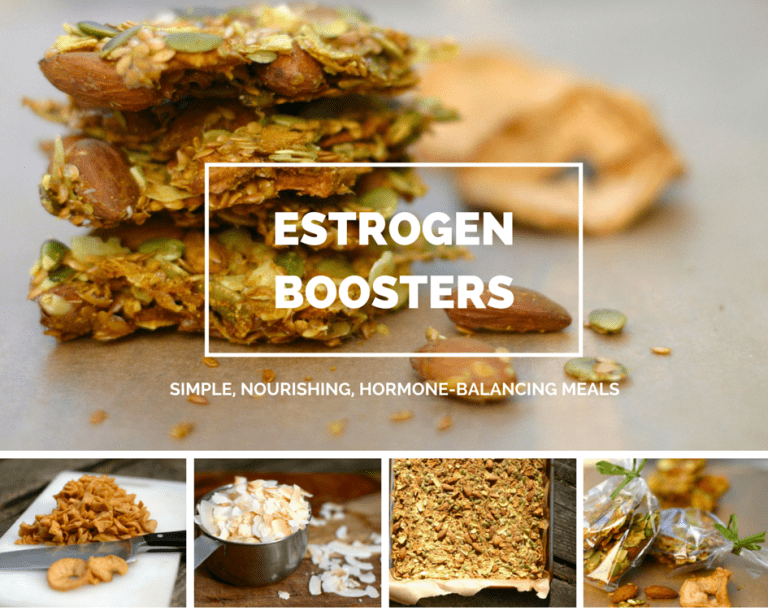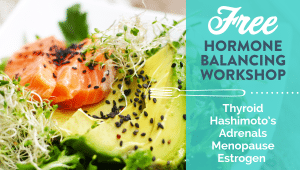It’s not very often that we hear about food helping to correct hormonal imbalances. In fact, when we hear the words “hormonal problems,” we are conditioned to think of solutions not extending much further than birth control pills, hormone creams and pallots.
Supporting the old mantra of “food is your medicine,” this article shows how innocent seeds can help regulate and support your hormonal balance.
The technique is called “seed rotation,” and can be used to bring back the sacred balance of estrogen and progesterone for menstruating, menopausal and post-menopausal women. (It is often wrongly assumed that post-menopausal women have “no more hormones.” This is very far from truth as we won’t be able to live without hormones).
For menstruating women, seed rotation helps to boost estrogen levels in the first part of the cycle and progesterone levels in the second part.
How to use seed rotation if you are still menstruating
This technique can be used by any woman who is experiencing irregular periods, heavy flows, substantial PMS, and even women going through peri-menopause and menopause.
The technique described here is based on a 30-day cycle, though most women’s cycles tend to run between 25 and 36 days. Only 10 to 15% of women have cycles that are exactly 28 to 30 days. Day 1 is counted as the first day of a period.
As an example, this article is based on a 30-day cycle.
What about women who do not menstruate or who are menopausal and postmenopausal?
If you do not have a cycle either because you are not menstruating or because you have entered peri-menopause, menopause or you are in post-menopause, seed rotation can still help.
If you are pre-menopausal and not cycling, start the seed rotation any time you like and do two weeks of each seed rotation, as shown in the below chart.
If you have already entered menopause, you can start applying seed rotation any time you like and keep each seed combination (like flax seed and pumpkin) for one to two weeks, then switch to the other combination (like sunflower and sesame seeds).
Which seeds should be used in what part of the cycle?
From Day 1 to Day 15 (or the middle of the cycle), we need more estrogen in order to build up our endometrium (uterus lining). This is called the follicular phase. With seeds such as flaxseed and pumpkin seeds, we can naturally increase our estrogen levels.
From Day 15 to Day 30, or the second part of the cycle (also known as the luteal phase), the corpus luteum begins to release progesterone. This sex hormone will help thicken the uterus lining and prepare it for implantation.
The high contents of zinc in sesame seeds and vitamin E in sunflower seeds have been shown to stimulate progesterone production (see references below). By adding two tablespoons of sesame and sunflower seeds per day in the luteal phase, we can naturally support the body to produce more progesterone, a sex hormone of which many women experience low levels.
See the Seed Rotation for Menstrual Cycle chart below.
 What does a balanced cycle look like?
What does a balanced cycle look like?
Of course, being regular is one important factor, but there is much more to a balanced cycle beyond that. So many of us are accustomed to feeling terrible before our period (and some women in the mid-cycle or during ovulation as well) that we assume it is normal. It is not.
High estrogen (or estrogen metabolites) can be the cause of tender breasts, mood swings, hair loss, weight gain, fibroids, endometriosis, breast and ovarian cysts, and even breast and ovarian cancer.
Low progesterone levels can manifest in ways similar to the above, along with feeling anxious, not being able to fall or stay asleep, and menstrual headaches.
Rebalancing your cycle using a simple food-based technique like seed rotation can help alleviate many of the symptoms in as little as one or two months. In a perfectly healthy woman, the menstrual cycle and the estrogen/progesterone production will happen naturally with no help or intervention.
This is, unfortunately, not the case for many women today. Excessive stress leading to excessive cortisol release, environmental toxins, poor diet, food sensitivities, digestive issues, and high coffee or alcohol consumption can all contribute to irregular or painful periods, and even infertility. Supporting the body with food that will help produce sufficient amounts of estrogen and progesterone is not only easy and cheap, but also non-invasive. This is why this form of healing is preferred by practitioners who work with food as medicine – this method simply works, while still being gentle on the body.
Why add more estrogen to our diet?
Many women worry that they are already experiencing estrogen dominance, so why add more estrogen in the form of phytoestrogens, such as flaxseed?
For this to be fully understood, we first need to establish that not all estrogens are “bad,” and the one that tends to be high in estrogen-dominant women is estradiol, also known as E2
.
Excessive levels of E2 have been linked to breast and prostate cancer. Flaxseed does not only suppress estradiol production, but it also nudges estradiol metabolism into a positive direction by generating a higher ratio of the protective metabolite 2-hydroxy-estrone versus the more harmful 16-hydroxy-estrone.
Easy ways of adding seed rotation to your diet
The easiest way to incorporate the seed combinations is by adding either two tablespoons of one seed or one tablespoon each of two different seeds to smoothies, salads or soups.
Another way to ensure regular seed consumption is by making your own seed crackers. They can easily be baked in a regular oven or prepared with a dehydrator.
RECIPE: Estrogen-boosting crackers [oven method]
Two tablespoons of flaxseed or pumpkin seeds per day have shown to help boost estrogen production. Pumpkin seeds are also known to be phytoestrogenic.
This can be equally valuable for menstruating women in the first part of the cycle (day 1 to 15, refer to the chart) as well as women going through peri- and menopause who would benefit from an estrogen boost.
This recipe is using an oven. If you have a dehydrator, feel free too use it and set it to 115°F for 8 hours.
Time to prepare: 20 minutes
Time to soak: 12 hours
Time to bake: 6 hours
Serves: 20 servings
Equipment: thermometer, parchment paper and 18’ x 13’ baking tray
Ingredients
1 cup almonds
1 cup flaxseed
1 cup pumpkin seeds
1 cup dried apples, roughly chopped
1 cup roasted coconut flakes
1 tablespoon apple cider vinegar
1 tablespoon curry powder
1 teaspoon sea salt
How to make
1. Soak almonds for 12 hours.
2. Soak flaxseed and pumpkin seeds in 3 cups of water for 2 hours.
3. Preheat the oven to 150F or the lowest temperature your oven allows. The trick to keeping the temperature low (ideally in the range of 120 to 150F) is to leave the oven door ajar. This will prevent the crackers from burning and will create air circulation to dry the crackers.
4. Strain all the excess water from the almonds and combine with all the remaining ingredients. Toss to mix them well.
5. Line the baking tray with parchment paper and spread the mixture evenly.
6. Bake for 6 hours or until fully dried. It’s recommended to check your crackers regularly using the thermometer to be sure they are getting dried but not burned. If the oven gets too hot, just open the oven door slightly wider. I use a metal tool (like a can opener) to keep the oven door ajar. The second batch will be easier to make as you will know how to keep the oven temperature in the 120-150F range.
These crackers store well for two weeks in an air-tight container.
More hormone-balancing Recipes
This article was contributed by my friend Magdalena Wszelaki, a nutritional coach, hormone specialist and chef. She has a long history of hormonal challenges herself, from Hashimoto’s and adrenal exhaustion to estrogen dominance. She is in a full remission today and lives a symptoms-free life.
Magdalena is running a free online workshop, “How to Use Food to Rebalance Your Hormones,” on March 12th, 2016.
To reserve your free spot, CLICK HERE.
The virtual seats are limited and her workshops tend to fill up quickly, so hurry if you want to save your online seat.
Medical References
“Zinc induced changes in the progesterone binding properties of the human endometrium,” European Society of Endocrinology
“Effect of dl-?-tocopherol acetate on progesterone metabolism,” Journal of Clinical Endocrinology & Metabolism
“Effect of dietary components, including lignans and phytoestrogens, on enterohepatic circulation and liver metabolism of estrogens and on sex hormone binding globulin (SHBG),” Journal of Steroid Biochemistry
“Effects of phytoestrogen extracts isolated from pumpkin seeds on estradiol production and ER/PR expression in breast cancer and trophoblast tumor cells,” Nutrition and Cancer, Taylor Francis Group.
“Phytoestrogens: the “natural” selective estrogen receptor modulators?” European Journal of Gynecology and Reproductive Biology




